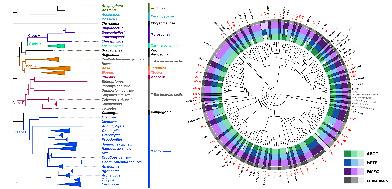当前位置:
X-MOL 学术
›
Syst. Entomol.
›
论文详情
Our official English website, www.x-mol.net, welcomes your feedback! (Note: you will need to create a separate account there.)
Museomics reveals extensive cryptic diversity of Australian prionine longhorn beetles with implications for their classification and conservation
Systematic Entomology ( IF 4.8 ) Pub Date : 2020-02-06 , DOI: 10.1111/syen.12424 Mengjie Jin 1, 2 , Andreas Zwick 2 , Adam Ślipiński 2 , Roger Keyzer 3 , Hong Pang 1
Systematic Entomology ( IF 4.8 ) Pub Date : 2020-02-06 , DOI: 10.1111/syen.12424 Mengjie Jin 1, 2 , Andreas Zwick 2 , Adam Ślipiński 2 , Roger Keyzer 3 , Hong Pang 1
Affiliation

|
We combined museum collection genomics and morphology to identify new genera and species, and to otherwise revise the taxonomy of the poorly understood Australian longhorn beetles in the subfamily Prioninae. Moreover, we produced a comprehensive DNA reference library for molecular species identification and a first comprehensive molecular phylogeny for all Australian Prioninae, using mitogenomic data. The Prioninae include some of the world's largest beetles, and their long‐lived larvae are major recyclers of solid dead timber, yet these longhorn beetles are rarely seen in nature due to their concealed habits, short adult lifespans and nocturnal habits. Furthermore, many species are difficult to identify using morphological characters. We applied Whole Genome Shotgun (WGS) sequencing to 213 historical museum specimens, representing all morphological types of Australian Prioninae. Complete mitochondrial genomes were obtained for all genera, and at least one mitochondrial protein‐coding gene (PCG) was acquired for an additional 141 specimens of Australian Prioninae. Using molecular species delimitation tools, we identified 48 new species of Australian Prioninae, nearly doubling the number of currently recognized Australian species of Prioninae. We assign generic status to Catypnes Pascoe, 1864 stat.r. and Hermerius Newman, 1844 stat.r., propose a new synonymy for Cnemoplites Newman, 1842 (= Paroplites Lameere, 1903 syn.n.), describe six new genera, including Paulhutchinsonia Jin, de Keyzer & Ślipiński gen.n., Papunya Jin, de Keyzer & Ślipiński gen.n., Dunmorium Jin, de Keyzer & Ślipiński gen.n., Hagrides Jin, de Keyzer & Ślipiński gen.n., Cryptipus Jin, de Keyzer & Ślipiński gen.n., Geoffmonteithia Jin, de Keyzer & Ślipiński gen.n., and revise the tribal composition of the Australian Macrotomini. Moreover, our phylogeny of Prioninae provides valuable new insights into the evolutionary origins and nearest relatives of several Australian endemic taxa. Our results emphasize the importance of natural history museums as a repository for information about biodiversity, and highlight the opportunities associated with using museum specimens as a source for molecular data in phylogenetic studies.
中文翻译:

博物馆组学揭示了澳大利亚朊氨酸长角甲虫的广泛神秘多样性及其分类和保护
我们结合博物馆藏品基因组学和形态学来识别新的属和种,并以其他方式修改对 Prioninae 亚科中知之甚少的澳大利亚长角甲虫的分类。此外,我们使用有丝分裂基因组数据为所有澳大利亚栉亚科制作了一个用于分子物种鉴定的综合 DNA 参考库和第一个综合分子系统发育。Prioninae 包括一些世界上最大的甲虫,它们长寿的幼虫是固体死木材的主要回收者,但由于它们的隐蔽习性、成年寿命短和夜间习性,这些长角甲虫在自然界中很少见。此外,许多物种难以使用形态特征来识别。我们将全基因组霰弹枪 (WGS) 测序应用于 213 个历史博物馆标本,代表澳大利亚朊亚科的所有形态类型。获得了所有属的完整线粒体基因组,并为另外 141 个澳大利亚栉亚科标本获得了至少一个线粒体蛋白编码基因 (PCG)。使用分子物种定界工具,我们确定了 48 种澳大利亚栉亚科新物种,几乎是目前公认的澳大利亚栉亚科物种数量的两倍。我们将通用状态分配给 Catypnes Pascoe, 1864 stat.r。和 Hermerius Newman, 1844 stat.r., 为 Cnemoplites Newman, 1842 (= Paroplites Lameere, 1903 syn.n.) 提出了一个新的同义词,描述了六个新属,包括 Paulhutchinsonia Jin、de Keyzer 和 Ślipiński gen.n.,Papunya Jin, de Keyzer & Ślipiński gen.n., Dunmorium Jin, de Keyzer & Ślipiński gen.n., Hagrides Jin, de Keyzer & Ślipiński gen.n., Cryptipus Jin, de Keyzer & Ślipiński gen.n., Geoffmonteithia Jin, de Keyzer & Ślipiński gen.n.,并修改了澳大利亚 Macrotomini 的部落组成。此外,我们对 Prioninae 的系统发育提供了对几种澳大利亚地方性分类群的进化起源和最近亲属的有价值的新见解。我们的研究结果强调了自然历史博物馆作为生物多样性信息存储库的重要性,并强调了与使用博物馆标本作为系统发育研究中分子数据来源相关的机会。我们对 Prioninae 的系统发育为了解澳大利亚地方性分类群的进化起源和近亲提供了宝贵的新见解。我们的研究结果强调了自然历史博物馆作为生物多样性信息存储库的重要性,并强调了使用博物馆标本作为系统发育研究中分子数据来源的机会。我们对 Prioninae 的系统发育为了解澳大利亚地方性分类群的进化起源和近亲提供了宝贵的新见解。我们的研究结果强调了自然历史博物馆作为生物多样性信息存储库的重要性,并强调了使用博物馆标本作为系统发育研究中分子数据来源的机会。
更新日期:2020-02-06
中文翻译:

博物馆组学揭示了澳大利亚朊氨酸长角甲虫的广泛神秘多样性及其分类和保护
我们结合博物馆藏品基因组学和形态学来识别新的属和种,并以其他方式修改对 Prioninae 亚科中知之甚少的澳大利亚长角甲虫的分类。此外,我们使用有丝分裂基因组数据为所有澳大利亚栉亚科制作了一个用于分子物种鉴定的综合 DNA 参考库和第一个综合分子系统发育。Prioninae 包括一些世界上最大的甲虫,它们长寿的幼虫是固体死木材的主要回收者,但由于它们的隐蔽习性、成年寿命短和夜间习性,这些长角甲虫在自然界中很少见。此外,许多物种难以使用形态特征来识别。我们将全基因组霰弹枪 (WGS) 测序应用于 213 个历史博物馆标本,代表澳大利亚朊亚科的所有形态类型。获得了所有属的完整线粒体基因组,并为另外 141 个澳大利亚栉亚科标本获得了至少一个线粒体蛋白编码基因 (PCG)。使用分子物种定界工具,我们确定了 48 种澳大利亚栉亚科新物种,几乎是目前公认的澳大利亚栉亚科物种数量的两倍。我们将通用状态分配给 Catypnes Pascoe, 1864 stat.r。和 Hermerius Newman, 1844 stat.r., 为 Cnemoplites Newman, 1842 (= Paroplites Lameere, 1903 syn.n.) 提出了一个新的同义词,描述了六个新属,包括 Paulhutchinsonia Jin、de Keyzer 和 Ślipiński gen.n.,Papunya Jin, de Keyzer & Ślipiński gen.n., Dunmorium Jin, de Keyzer & Ślipiński gen.n., Hagrides Jin, de Keyzer & Ślipiński gen.n., Cryptipus Jin, de Keyzer & Ślipiński gen.n., Geoffmonteithia Jin, de Keyzer & Ślipiński gen.n.,并修改了澳大利亚 Macrotomini 的部落组成。此外,我们对 Prioninae 的系统发育提供了对几种澳大利亚地方性分类群的进化起源和最近亲属的有价值的新见解。我们的研究结果强调了自然历史博物馆作为生物多样性信息存储库的重要性,并强调了与使用博物馆标本作为系统发育研究中分子数据来源相关的机会。我们对 Prioninae 的系统发育为了解澳大利亚地方性分类群的进化起源和近亲提供了宝贵的新见解。我们的研究结果强调了自然历史博物馆作为生物多样性信息存储库的重要性,并强调了使用博物馆标本作为系统发育研究中分子数据来源的机会。我们对 Prioninae 的系统发育为了解澳大利亚地方性分类群的进化起源和近亲提供了宝贵的新见解。我们的研究结果强调了自然历史博物馆作为生物多样性信息存储库的重要性,并强调了使用博物馆标本作为系统发育研究中分子数据来源的机会。



























 京公网安备 11010802027423号
京公网安备 11010802027423号